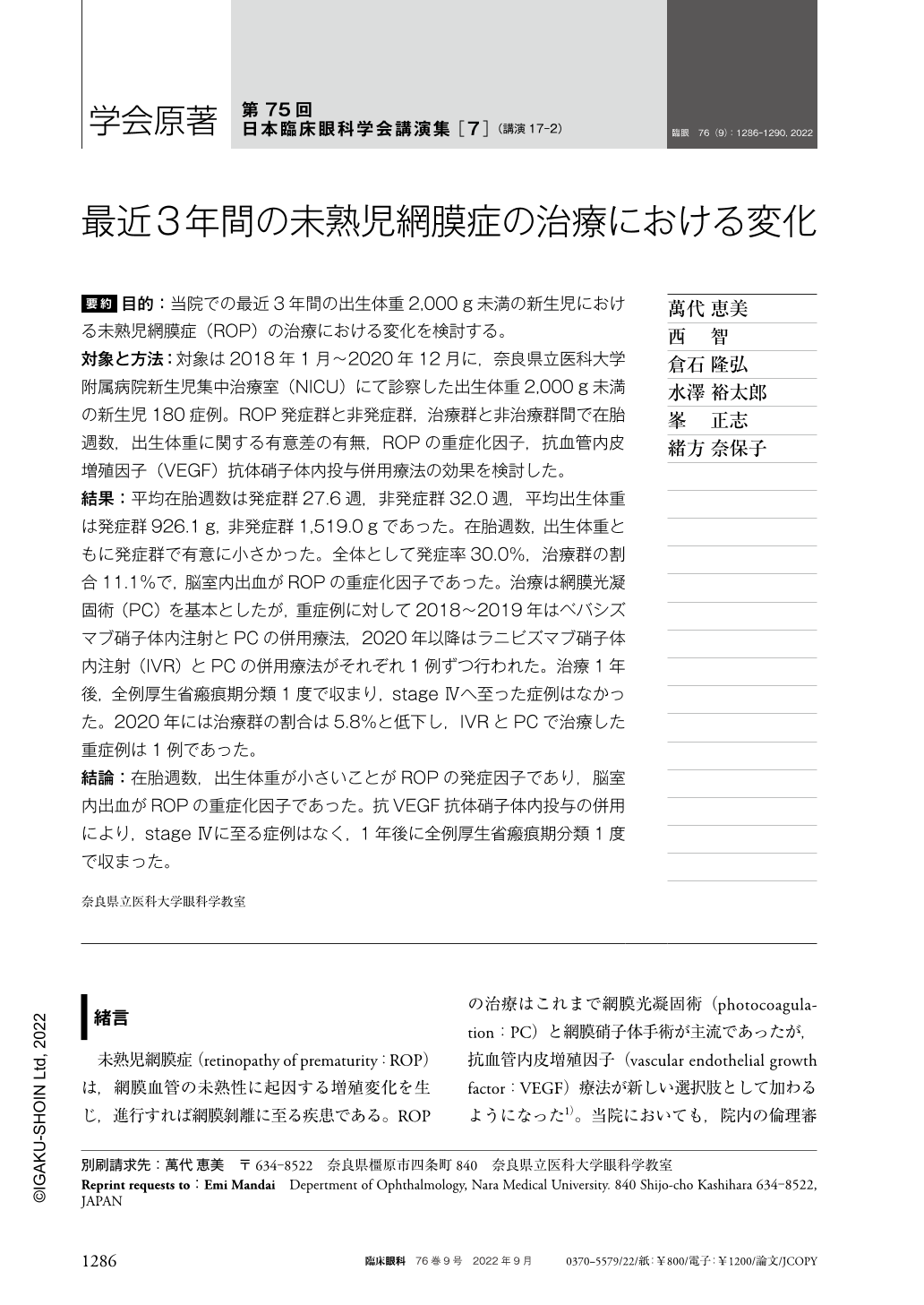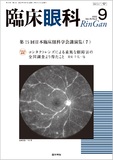Japanese
English
- 有料閲覧
- Abstract 文献概要
- 1ページ目 Look Inside
- 参考文献 Reference
要約 目的:当院での最近3年間の出生体重2,000g未満の新生児における未熟児網膜症(ROP)の治療における変化を検討する。
対象と方法:対象は2018年1月〜2020年12月に,奈良県立医科大学附属病院新生児集中治療室(NICU)にて診察した出生体重2,000g未満の新生児180症例。ROP発症群と非発症群,治療群と非治療群間で在胎週数,出生体重に関する有意差の有無,ROPの重症化因子,抗血管内皮増殖因子(VEGF)抗体硝子体内投与併用療法の効果を検討した。
結果:平均在胎週数は発症群27.6週,非発症群32.0週,平均出生体重は発症群926.1g,非発症群1,519.0gであった。在胎週数,出生体重ともに発症群で有意に小さかった。全体として発症率30.0%,治療群の割合11.1%で,脳室内出血がROPの重症化因子であった。治療は網膜光凝固術(PC)を基本としたが,重症例に対して2018〜2019年はベバシズマブ硝子体内注射とPCの併用療法,2020年以降はラニビズマブ硝子体内注射(IVR)とPCの併用療法がそれぞれ1例ずつ行われた。治療1年後,全例厚生省瘢痕期分類1度で収まり,stage Ⅳへ至った症例はなかった。2020年には治療群の割合は5.8%と低下し,IVRとPCで治療した重症例は1例であった。
結論:在胎週数,出生体重が小さいことがROPの発症因子であり,脳室内出血がROPの重症化因子であった。抗VEGF抗体硝子体内投与の併用により,stage Ⅳに至る症例はなく,1年後に全例厚生省瘢痕期分類1度で収まった。
Abstract Purpose:To review changes in the treatment of retinopathy of prematurity(ROP)in newborns with a birth weight of less than 2,000 g in the last 3 years in Nara Medical University Hospital.
Method:In this study, 180 newborns who were examined at the Neonatal Intensive Care Unit(NICU)of Nara Medical University Hospital between January 2018 and December 2020 were enrolled. We investigated whether there were significant differences in the gestational age and birth weight between the ROP group and the non-ROP group and between the treated ROP group and the non-treated ROP group. We also investigated the severity factor of ROP and the effects of anti-VEGF combination therapy.
Result:The average gestational age was 27.6 weeks in the ROP group and 32.0 weeks in the non-ROP group. The average birth weight was 926.1 g in the ROP group and 1519.0 g in the non-ROP group. Both birth weight and gestational age were significantly lesser in the ROP group. ROP developed in 30.0% of 180 newborns and the treatment was provided in 11.1% cases. The severity factor of ROP was intraventricular hemorrhage. We treated them with retinal photocoagulation(PC). In severe cases, intravitreal bevacizumab(IVB)and PC were used between 2018 and 2019, intravitreal ranibizumab(IVR)and PC were used in 2020, one case each. One year after the treatment, all patients had a scarring grade Ⅰ. No cases led to stage Ⅳ. In 2020, the treatment rate decreased to 5.8%. Only one severe case was treated with IVR and PC.
Conclusions:The low gestational age and birth weight are responsible for the onset of ROP. The severity factor of ROP was intraventricular hemorrhage. No cases led to stage Ⅳ due to the PC and anti-VEGF intravitreal injection combination therapy. All patients had a scarring grade Ⅰ one year after treatment.

Copyright © 2022, Igaku-Shoin Ltd. All rights reserved.


